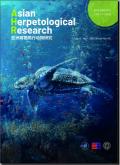A New Species of the Genus Tylototriton (Urodela: Salamandridae) from Northeastern Hunan Province, China
IF 1.2
3区 生物学
Q2 ZOOLOGY
引用次数: 13
Abstract
We describe a new species from the family Salamandridae from northeastern Hunan Province of China based on morphological and molecular genetic evidences. The new species, Tylototriton liuyangensis, is a member of the T asperrimus group, and shares a number of similarities with T wenxianensis and T broadoridgus. The dorsal surface of the new Tylototriton species is completely black, with nodule-like warts distributed evenly along the lateral margin of dorsal body, and there is no transverse striae between the warts. There are several diagnostic characters of the new species that differ from those of T wenxianensis and T broadoridgus as follows: (1) the interorbital space (IOS) is comparatively wide; (2) there is a bony ridge present on the dorsal head surface, running along the upper eyelids; (3) the space between axilla and groin (AGS) is comparatively large, with the mean male AGS approximately equal to 50% of the snout-vent length (SVL) and the mean female AGS being 53% of SVL; and (4) there is a small genital armature on the anterior angle of labial folds present inside the anal fissure of adult males during the breeding season. The result from the molecular phylogenetic analysis of the genus Tylototriton (including the type specimen of the new species) based on the complete DNA sequence of the mitochondrial ND2 gene (1035 bp) indicated that the new species was similar to T wenxianensis, T dabienicus, and T broadoridgus, but formed an independent clade. This result was consistent with the morphological analysis above, supporting that the Liuyang Population represented a distinct species.文章题目湖南东北蝾螈属一新种(尾纲:蝾螈科)
根据形态学和分子遗传学证据,描述了湖南东北部蝾螈科一新种。新种Tylototriton liuyangensis是T asperrimus组的成员,与T wenxianensis和T broadoridgus有许多相似之处。新种褐家鼠背表面全黑,瘤状疣沿背体外侧缘均匀分布,疣间无横纹。该新种与文仙T和broadoridgus的诊断特征有以下几点不同:(1)眶间空间(IOS)较宽;(2)在头背表面有骨脊,沿上眼睑延伸;(3)腋窝与腹股沟间距较大,雄性平均约为鼻口长度(SVL)的50%,雌性平均为SVL的53%;(4)在繁殖季节,成年雄性的肛裂内唇褶的前角处有一个小的生殖枢。基于线粒体ND2基因全序列(1035 bp)对Tylototriton属(包括新种模式标本)的分子系统发育分析结果表明,新种与T wenxianensis、T dabienicus和T broadoridgus相似,但形成一个独立的分支。这一结果与上述形态学分析相一致,支持浏阳居群是一个独特的种。
本文章由计算机程序翻译,如有差异,请以英文原文为准。
求助全文
约1分钟内获得全文
求助全文
来源期刊

Asian Herpetological Research
ZOOLOGY-
CiteScore
2.80
自引率
7.10%
发文量
441
审稿时长
>12 weeks
期刊介绍:
AHR aims to provide a forum for herpetologists and related scientists interested in conducting international academic exchanges and joint studies, and a platform for introducing their newly made scientific and technological data, and publishing their research results and achievements in the world, but focusing on the Asian-Pacific Region.
The principal criteria of AHR for acceptance of articles for publication are the quality and significance of the research, breadth of interest of the work to the readership, and the clarity and effectiveness of communication. AHR welcomes submission of manuscripts from authors in all countries of the world, though with a focus on the herpetological studies in the Asian and Pacific Region, including major articles, shorter communications and review articles.
 求助内容:
求助内容: 应助结果提醒方式:
应助结果提醒方式:


